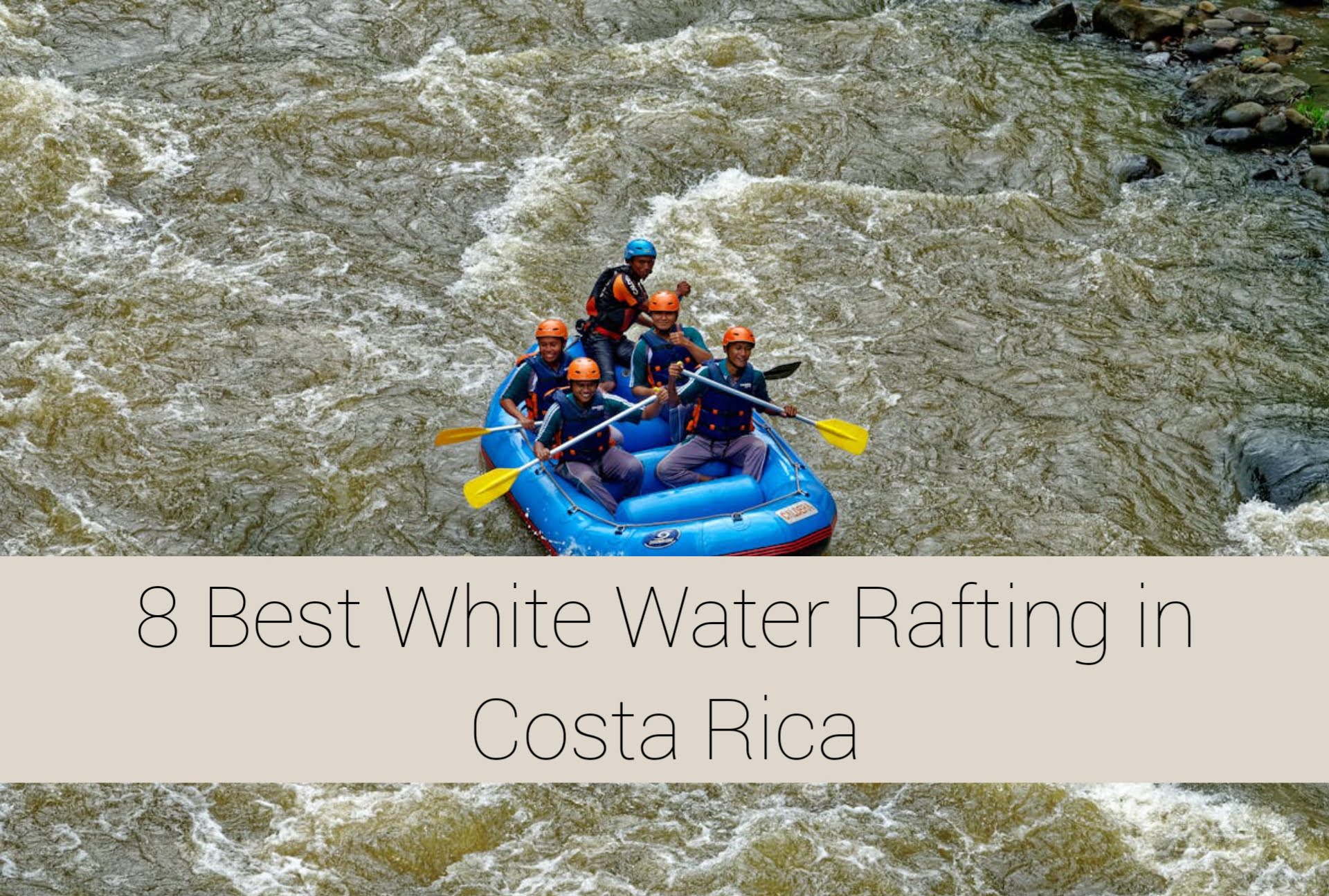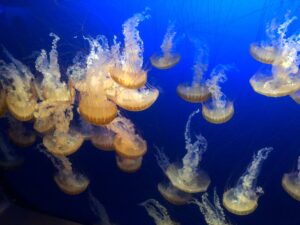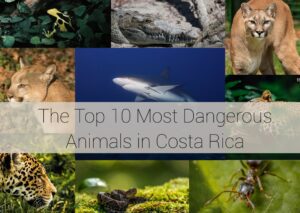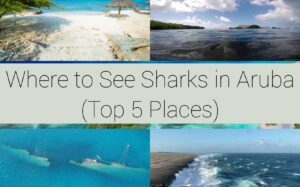Costa Rica is a great place to visit and have lots of fun. This small Central American country has a lot of destinations to explore and activities to indulge in.
One such activity is whitewater rafting, and this is made possible due to more than 14 major river systems that flow from the volcanic mountains to the coasts. This creates some of the most exciting rapids in the world.
In this article, I will share with you the 8 best whitewater rafting spots in Costa Rica, as well as some tips and information to help you plan your trip.
What is White Water Rafting?
For those that might notice, whitewater rafting is a sport that involves navigating a river on an inflatable raft, which usually happens with a guide and a group of other people.
The raft is propelled by paddles and the current of the water, and the goal is to avoid obstacles and stay on course. The difficulty of the rapids is classified on a scale from I to VI, where I is the easiest and VI is the most extreme.

Whitewater rafting is a fun activity that can be enjoyed by anyone who loves water and nature. It is also a great way to see the beauty of Costa Rica, as you will pass through rainforests, valleys, and waterfalls.
Why is Costa Rica a Great Destination for White Water Rafting?
There are many unique reasons why Costa Rica is a great destination for whitewater rafting. They are:
1. Tropical Climate
Costa Rica is a region that has a tropical climate. This climate makes the water warm and comfortable all year.
The average temperature of the water is around 80°F (26°C), which is much warmer than in other popular rafting destinations like Canada or Utah.
2. Seasons
Costa Rica has a rainy season that runs from June to October, which is the best time to go whitewater rafting. The rain makes the rivers fuller and faster, creating more exciting and challenging rapids.
3. Rivers
Costa Rica has a variety of rivers that offer different levels of difficulty and scenery. You can choose from calm and scenic floats to wild and adrenaline-pumping rides, depending on your preference and skill.
You can also choose from different lengths and locations of the tours, from half-day to multi-day trips, and from the Caribbean to the Pacific coast.
4. Safety
Costa Rica has a high standard of safety and quality for whitewater rafting. The guides are well-trained and experienced, and the equipment is well-maintained and certified.
The tours also include transportation, meals, and insurance, so you don’t have to worry about anything.
8 Best White Water Rafting in Costa Rica
Now that you know what whitewater rafting is and why Costa Rica is a great place to do it, let’s take a look at the 8 best whitewater rafting spots in Costa Rica.
These are the rivers that I recommend you try, based on my research and personal experience.
1. Pacuare River
The Pacuare River is one of the most popular and famous rivers for whitewater rafting in Costa Rica. This is because it offers a combination of a wonderful view of the scenery and the rich culture of the region.
The Pacuare River is located on the Caribbean side of the country, and it flows for about 68 miles (110 km) from the Talamanca Mountains to the sea.
It has more than 52 rapids, ranging from class II to IV, which means that it is suitable for intermediate to advanced rafters. Some of the most notable rapids are “The Valley of the Jaguar,” “The Double Drop,” and “The Upper and Lower Huacas.”.

The Pacuare River is not only about the rapids, though. It is also a beautiful and diverse river that passes through dense rainforests, deep gorges, and indigenous territories. Along the way, you will see waterfalls, wildlife, and local villages.
You will also have the opportunity to learn about the culture and history of the Cabecar people, who live in harmony with nature along the river. The Pacuare River is a protected area, and rafting is one of the best ways to support the conservation and development of this region.
The Pacuare River can be rafted in one day or two days, depending on your preference and availability. The one-day tour usually covers about 18 miles (30 km) of the river, and it takes about 4 hours of rafting.
The two-day tour covers the entire river, and it includes an overnight stay at a lodge or a campsite along the river.
The two-day tour is more immersive and adventurous, as you will get to experience the river at different times of the day and night.
The Pacuare River is accessible from different locations in Costa Rica, such as San Jose, Puerto Viejo, Arenal, and Turrialba.
The tours usually include transportation from and to your hotel, as well as meals, snacks, and drinks. The price of the tours varies depending on the length, the season, and the company, but it usually ranges from $100 to $300 per person.
2. Balsa River
The Balsa River is another great option for whitewater rafting in Costa Rica, especially for beginners and families. It is located near La Fortuna, the town that is famous for the Arenal Volcano and the hot springs.
The Balsa River is a class II-III river, which means that it has some fun and easy rapids, as well as some calm and scenic sections. The rapids have names like “Magnetic Rock,” “Dredges,” and “Congo Loco.”.
The Balsa River is also a great place to see the wildlife and nature of Costa Rica, as it flows through a lush and green valley. You will see monkeys, sloths, iguanas, toucans, and other birds along the river.
You will also see pineapple and sugar cane plantations, and you will learn about the local agriculture and economy. The river is clean and refreshing, and you will have the chance to swim and relax in some of the pools and eddies.
The Balsa River can be rafted in half a day or a full day, depending on your preference and availability. The half-day tour usually covers about 6 miles (10 km) of the river, and it takes about 2 hours of rafting.
The full-day tour covers about 12 miles (20 km) of the river, and it takes about 4 hours of rafting. The full-day tour also includes a visit to a local farm, where you will enjoy a typical Costa Rican lunch and learn about rural life and culture.
The Balsa River is easily accessible from La Fortuna, and the tours usually include transportation from and to your hotel, as well as meals, snacks, and drinks.
The price of the tours varies depending on the length, the season, and the company, but it usually ranges from $60 to $100 per person.

3. Sarapiqui River
Another place to go whitewater rafting in Costa Rica is the Sarapiqui River. This location is ideal for those who want to combine adventure and nature.
It is located in the northern region of the country, near the border with Nicaragua. The Sarapiqui River is a class III-IV river, which means that it has some challenging and exciting rapids as well as some smooth and relaxing sections.
Some of the most notable rapids are “The Pipeline,” “The Terminator,” and “The Devil’s Elbow.”.
The Sarapiqui River is also a wonderful place to see the biodiversity and beauty of Costa Rica, as it flows through a tropical rainforest that is home to more than 500 species of birds, 150 species of mammals, and 100 species of reptiles and amphibians.
You will see monkeys, sloths, crocodiles, turtles, and colorful birds along the river. You will also see exotic plants and flowers, and you will learn about the ecology and conservation of this area.
The Sarapiqui River can be rafted in half a day or a full day, depending on your preference and availability. The half-day tour usually covers about 8 miles (13 km) of the river, and it takes about 2 hours of rafting.
The full-day tour covers about 16 miles (26 km) of the river, and it takes about 4 hours of rafting. The full-day tour also includes a visit to a chocolate farm, where you will enjoy a delicious chocolate tasting and learn about the history and production of this sweet treat.
The Sarapiqui River is accessible from different locations in Costa Rica, such as San Jose, La Fortuna, and Puerto Viejo. The tours usually include transportation from and to your hotel, as well as meals, snacks, and drinks.
The price of the tours varies depending on the length, the season, and the company, but it usually ranges from $80 to $120 per person.
4. Savegre River
The Savegre River is another amazing option for whitewater rafting in Costa Rica, especially for those who want to enjoy a peaceful and scenic ride.
It is located near Manuel Antonio, a town that is famous for its beautiful beaches and national park. The Savegre River is a class II-III river, which means that it has some gentle and moderate rapids, as well as some calm and smooth sections. The rapids have names like “The Washing Machine,” “The Cheese Grater,” and “The Pinball.”.
The Savegre River is also a great place to see the nature and wildlife of Costa Rica, as it flows through a pristine and protected rainforest that is part of Los Quetzales National Park.
You will see waterfalls, orchids, bromeliads, and ferns along the river. You will also see monkeys, toucans, hummingbirds, and quetzals, the national bird of Costa Rica.
The Savegre River can be rafted in half a day or a full day, depending on your preference and availability. The half-day tour usually covers about 8 miles (13 km) of the river, and it takes about 2 hours of rafting.
The full-day tour covers about 16 miles (26 km) of the river, and it takes about 4 hours of rafting. The full-day tour also includes a visit to a local village, where you will enjoy a traditional Costa Rican lunch and learn about rural life and culture.
The Savegre River is easily accessible from Manuel Antonio, and the tours usually include transportation from and to your hotel, as well as meals, snacks, and drinks.
The price of the tours varies depending on the length, the season, and the company, but it usually ranges from $70 to $110 per person.
5. Naranjo River
The Naranjo River is another fantastic option for whitewater rafting in Costa Rica, especially for those who want to experience a fast and furious ride.
It is located near Quepos, a town that is famous for fishing and surfing. The Naranjo River is a class III-IV river, which means that it has some intense and challenging rapids, as well as some steep and narrow sections. The rapids have names like “The Dragon,” “The Needle,” and “The El Chorro.”.
The Naranjo River is also a great place to see the landscape and agriculture of Costa Rica, as it flows through mountainous and rocky terrain. You will see coffee, banana, and palm plantations, as well as cattle ranches and small villages.
You will also see some of the highest peaks and volcanoes in the country, such as the Cerro de la Muerte and the Irazu Volcano. The Naranjo River is muddy and powerful, and you will have the opportunity to test your skills and adrenaline in some of the rapids and drops.
The Naranjo River can be rafted in half a day or a full day, depending on your preference and availability. The half-day tour usually covers about 6 miles (10 km) of the river, and it takes about 2 hours of rafting.
The full-day tour covers about 12 miles (20 km) of the river, and it takes about 4 hours of rafting. The full-day tour also includes a visit to a waterfall, where you will enjoy a refreshing swim and a picnic lunch.
The Naranjo River is easily accessible from Quepos and Manuel Antonio, and the tours usually include transportation from and to your hotel, as well as meals, snacks, and drinks.
The price of the tours varies depending on the length, the season, and the company, but it usually ranges from $80 to $120 per person.

6. Tenorio River
The Tenorio River is another wonderful option for whitewater rafting in Costa Rica, especially for those who want to have a fun and adventurous ride. It is located near Liberia, the capital of the Guanacaste province.
The Tenorio River is a class III-IV river, which means that it has some exciting and technical rapids as well as some smooth and scenic sections. The rapids have names like “The Cascabel”, “The Rock Garden”, and “The Corkscrew”.
The Tenorio River is also a great place to see the nature and wildlife of Costa Rica, as it flows through a tropical dry forest that is part of the Tenorio Volcano National Park. You will see trees, flowers, and cacti along this blue river. You will also see monkeys, coatis, iguanas, and birds along the river.
The Tenorio River can be rafted in half a day or a full day, depending on your preference and availability. The half-day tour usually covers about 8 miles (13 km) of the river, and it takes about 2 hours of rafting.
The full-day tour covers about 16 miles (26 km) of the river, and it takes about 4 hours of rafting. The full-day tour also includes a visit to the famous Rio Celeste, a river that has a unique turquoise color due to a natural phenomenon.
The Tenorio River is accessible from different locations in Costa Rica, such as Liberia, Tamarindo, and La Fortuna. The tours usually include transportation from and to your hotel, as well as meals, snacks, and drinks.
The price of the tours varies depending on the length, the season, and the company, but it usually ranges from $90 to $130 per person.
7. Corobici River
The Corobici River is another awesome option for whitewater rafting in Costa Rica, especially for those who want to enjoy a relaxing and family-friendly ride. It is located near Cañas, a town that is famous for its windmills and renewable energy.
The Corobici River is a class I-II river, which means that it has some mild and easy rapids, as well as some calm and smooth sections. The rapids have names like “The Crocodile,” “The Monkey,” and “The Turtle.”.
The Corobici River is also a great place to see the wildlife and nature of Costa Rica, as it flows through a tropical dry forest that is part of the Palo Verde National Park. You will see trees, flowers, and grasses along the river. You will also see crocodiles, monkeys, turtles, and birds along the river.
The Corobici River can be rafted in half a day or a full day, depending on your preference and availability. The half-day tour usually covers about 6 miles (10 km) of the river, and it takes about 2 hours of rafting.
The full-day tour covers about 12 miles (20 km) of the river, and it takes about 4 hours of rafting. The full-day tour also includes a visit to Palo Verde National Park, where you will enjoy a guided hike and a boat tour.
The Corobici River is easily accessible from Cañas, and the tours usually include transportation from and to your hotel, as well as meals, snacks, and drinks.
The price of the tours varies depending on the length, the season, and the company, but it usually ranges from $70 to $110 per person.
8. Reventazon River
The Reventazon River is another amazing option for whitewater rafting in Costa Rica, especially for those who want to experience a varied and adventurous ride. It is located near Turrialba, a town that is famous for its cheese and volcano.
The Reventazon River is a class III-V river, which means that it has some of the most difficult and extreme rapids in the country, as well as some smooth and scenic sections. The rapids have names like “The Wall,” “The Squeeze,” and “The Florida.”.
The Reventazon River is also a great place to see the landscape and culture of Costa Rica, as it flows through a mountainous and rural area. The places you will see include hills, valleys, and farms along the river.
You will also see bridges, dams, and towns along the river. You will also learn about the history and importance of the river for the development and electricity of the country.
The Reventazon River is brown and powerful, and you will have the opportunity to test your skills and adrenaline in some of the rapids and drops.
The Reventazon River can be rafted in half a day or a full day, depending on your preference and availability. The half-day tour usually covers about 6 miles (10 km) of the river, and it takes about 2 hours of rafting.
The full-day tour covers about 12 miles (20 km) of the river, and it takes about 4 hours of rafting. The full-day tour also includes a visit to a local market, where you will enjoy a typical Costa Rican lunch and buy some souvenirs.
The Reventazon River is accessible from Turrialba and San Jose, and the tours usually include transportation from and to your hotel, as well as meals, snacks, and drinks.
The price of the tours varies depending on the length, the season, and the company, but it usually ranges from $90 to $130 per person.
Conclusion
Whitewater rafting is one of the best activities to do in Costa Rica, and this article has provided you with information about the 8 best places to go whitewater rafting in Costa Rica.
I hope this article guides you in picking the best place to go whitewater rafting in Costa Rica.
FAQs
What do I need to bring for whitewater rafting in Costa Rica?
When going for whitewater rafting in Costa Rica, bring comfortable clothes that can get wet, such as a swimsuit, shorts, and a T-shirt.
Also come along with shoes that can get wet and stay on your feet, such as water shoes, sandals, or sneakers.
Other things you should also bring are sunscreen, sunglasses, a hat, a towel, and a change of clothes. You don’t need to bring any valuables, as they might get lost or damaged in the water.
Is it safe to go white water rafting in Costa Rica?
Yes, it is safe to go whitewater rafting in Costa Rica. This is because there are lessons to be learned before getting into the water. You will learn how to maneuver your way safely, and what safety measures to take in the water.
How much does white water rafting in Costa Rica cost?
The cost of whitewater rafting in Costa Rica varies depending on the river, the length, the season, and the company, but in general, it ranges from $60 to $300 per person.
The cost usually includes transportation, meals, snacks, drinks, equipment, insurance, and taxes. You may also want to tip your guide and driver, as they work hard to make your trip enjoyable and safe.
When is the best time to go white water rafting in Costa Rica?
The best time to go whitewater rafting in Costa Rica is during the rainy season, which runs from June to October. This is when the rivers are fuller and faster, creating more exciting and challenging rapids.

Hi, I’m Louis Ojibe, and I grew up around wildlife in Africa. I have always been fascinated by animals and nature across the world.
As a child, my parents used to take me to see wild animals like lions, elephants, gorillas, tortoises, and many others at our local zoo.












